(Press-News.org) One only needs to glance at the news, social media, or even just out the window to understand the devastation caused by flooding. Recent back-to-back major hurricanes have brought catastrophic rainfall that has devastated communities across the southeastern United States.
With climate change, experts predict these extreme weather events will increasingly become the norm. Among the many ways that researchers are devising strategies to protect and assist vulnerable areas, one such effort involves increasing the speed and accuracy of damage assessments.
“Research shows that if you can save a single day in the initial response phase, it could save thousands of days in the recovery phase because the effect is logarithmic,” says Lehigh University researcher Maryam Rahnemoonfar, an associate professor of computer science and engineering with a joint appointment in the Department of Civil and Environmental Engineering.
Rahnemoonfar is part of a team led by North Carolina Agricultural and Technical State University (NCAT) that recently received a nearly $1 million grant from the National Science Foundation to support their innovative approach to mapping and assessing flood damage. The award, of which Lehigh will receive $160,000, is part of NSF’s Historically Black Colleges and Universities – Excellence in Research program, which funds research at public and private HBCUs to strengthen research capacity and promote engagement with NSF.
This collaboration between Lehigh and NCAT grew out of efforts within Lehigh's Interdisciplinary Research Institutes (IRIs) to foster cross-institutional partnerships that address critical challenges.
A ‘more comprehensive picture’ of disaster zones
Current post-disaster damage assessments typically rely on data from time-consuming manual methods, like ground-based gauges, and remote sensing technologies, such as satellite imagery. Although useful, such tools are localized and provide only a fragmented view of affected areas. They also lack multi-resolution data.
“Optical imagery doesn’t allow you to see below the surface, so you can miss critical information about what’s under the water, like roads and bridges,” says Rahnemoonfar. “But with radar sensors, you can detect submerged objects and get a more comprehensive picture.”
The team will combine multi-modal data sources—including satellite, UAV (unmanned aerial vehicle), and various remote-sensing technologies, such as optical, SAR (Synthetic Aperture Radar), and LiDAR (Light Detection and Ranging)—into a novel framework that automatically extracts spatial and temporal features from these data streams. And they’ll combine all of that with an innovative vision language model that the Lehigh team led by Rahnemoonfar will create.
“Vision language models will be built into a flying or ground-based robot that a response team can communicate with,” she says. “First responders might ask questions like, ‘What roads are flooded?’ or ‘Which neighborhoods are under water?’ and based on the robot’s answer, the team could more efficiently allocate their resources. We’re combining the language and visual domains.”
Rahnmoonfar has developed such models in the past for RGB sensors, but the algorithms that powered them are fully supervised, meaning they require a huge amount of labeled training data in order to identify and learn patterns. Her team will develop a self-supervised algorithm that requires far less data and will use information from their multi-modal data sources and from previous floods.
“Ultimately, we want to develop a system that can assist the rapid response and recovery required after weather disasters,” she says.
Lehigh’s IRIs: Seeding collaborations
The partnership between Lehigh and NCAT was initially facilitated by a seed grant from the Institute for Data, Intelligent Systems, and Computation (I-DISC), one of Lehigh’s three Interdisciplinary Research Institutes (IRIs)
“The goal of all Lehigh’s IRIs is to bring faculty from different areas of expertise and different backgrounds together to address major societal problems,” says Himanshu Jain, T.L. Diamond Distinguished Chair in Engineering and Applied Science and a professor of materials science and engineering. Jain recently stepped down as inaugural director of Lehigh’s Institute for Functional Materials and Devices (I-FMD), a role he held since 2018.
In his capacity as a faculty member, Jain has worked with HBCUs for the past 20 years—including a teaching stint at Tuskegee University—and through his work with I-FMD, he connected with Lehigh alum Jagannathan Sankar '83 PhD, a distinguished professor in NCAT’s Department of Mechanical Engineering.
“NCAT’s researchers are highly regarded,” says Jain, “and through our connection with Professor Sankar, we started developing ideas around how we could bring our faculty together.”
The discussions eventually led to Jain organizing “seed interactions”—virtual meetings where faculty from both institutions could brainstorm possible collaborations. Jain also established seed funding within Lehigh’s IRIs to help potential ideas get off the ground.
As a participant in these meetings, Rahnemoonfar met a colleague at NCAT, Leila Hashemi Beni, an associate professor in the Department of Built Environment, whose research area and interests complemented her own. With the seed funding, Rahnemoonfar and Beni were able to refine the idea that eventually led to the funded NSF award.
“What we wanted to demonstrate with these seed interactions is that they’re effective and lead to fruitful collaboration,” says Jain. “It’s the beginning of what we want to establish as a track record of our institutions successfully working together. What we ultimately want from the IRIs is for them to help incubate focused research centers devoted to addressing big, consequential societal issues. With NCAT, we are not only technically interested in each other’s expertise, but we have a scientific synergy that can have a significant impact on some of the world’s biggest problems.”
END
Lehigh partners with North Carolina A&T to enhance flood damage mapping with AI and advanced radar
Universities to collaborate in National Science Foundation-funded effort to transform flood damage assessments through the agency’s “HBCU Excellence in Research” program
2024-11-13
ELSE PRESS RELEASES FROM THIS DATE:
2024 AAAS Kavli Science Journalism Award winners named
2024-11-13
Stories on the discovery of vital fluid-transport systems in the human body are among the winners of the 2024 AAAS Kavli Science Journalism Awards. Winning journalists also did immersive stories on scientists and physicians at work – in the field, in the lab and in the emergency room.
Independent panels of science journalists select the winners of the awards, which are administered by the American Association for the Advancement of Science (AAAS) and endowed by The Kavli Foundation. There is a Gold Award ($5,000) and Silver Award ($3,500) for each of the eight categories. The global awards program drew entries ...
Collaborative of prominent academic institutions launches groundbreaking healthcare AI challenge
2024-11-13
Mass General Brigham AI is hosting the Healthcare AI Challenge, a multi-institutional virtual, interactive series of events where healthcare professionals can explore and assess the latest AI healthcare technologies in real-world healthcare scenarios.
The Healthcare AI Challenge Collaborative is launching with a diverse set of healthcare institutions and their healthcare professionals, including Mass General Brigham; Emory Healthcare; the Department of Radiology at the University of Wisconsin School of Medicine and Public Health; and the Department of Radiology at the University of Washington School of Medicine. The American College of Radiology (ACR), ...
American Federation for Aging Research announces 2024 AFAR grants for junior faculty
2024-11-13
NEW YORK, NY— The American Federation for Aging Research (AFAR) is pleased to announce the recipients of its 2024 AFAR Grants for Junior Faculty. The AFAR Grants for Junior Faculty program provides up to $150,000 for a one- to two-year award to junior faculty (MDs and PhDs) to conduct research that will serve as the basis for longer term research efforts on the biology of aging. The major goal of this program is to assist in the development of the careers of early career investigators committed to pursuing careers in aging research. Selected through ...
Potential single-dose smallpox and mpox vaccine moves forward
2024-11-13
Highlights:
An FDA-approved vaccine for smallpox and mpox is effective but causes side effects. The other requires multiple doses.
An experimental single-dose vaccine uses the horsepox virus to harness the benefits of both strategies.
Previous studies suggest that inoculation with horsepox elicits an antibody response to mpox and provides 100% protection in animal models.
New data show that the horsepox virus is significantly more attenuated, or weakened, compared to the virus used in the FDA-approved live virus vaccine.
Washington, D.C.—Vaccines that prevent smallpox and mpox come in 2 varieties. One uses a single shot of a live virus but ...
Mass General Brigham Gene and Cell Therapy Institute names Spark Grant recipients
2024-11-13
The Mass General Brigham Gene and Cell Therapy Institute, a hub of innovation dedicated to accelerating groundbreaking research, conducting clinical trials and developing FDA-approved treatments, today announced four winning project groups, consisting of seven individuals, of its second annual Spark Grant program. The program was created to fund gene and cell therapy projects by Mass General Brigham investigators that demonstrate tangible advancements towards clinical applications and commercialization outcomes, including licensing, partnerships, or new company creation. A total of $1,150,000 ...
New discovery may lead to more effective treatment for cardiovascular disease
2024-11-13
CLEVELAND—Researchers at Case Western Reserve University have identified a new target to treat atherosclerosis, a condition where plaque clogs arteries and causes major cardiac issues, including stroke and heart attack.
In a new study, published in the journal Cell Reports, they identified an inflammation-reducing molecule—called itaconate (ITA)—that could be the foundation of a new approach to treat such a common and deadly disease.
Heart disease is the leading cause of death for ...
Developing advanced recycling technology to restore spent battery cathode materials
2024-11-13
A research team led by Dr. Jung-Je Woo at the Gwangju Clean Energy Research Center of the Korea Institute of Energy Research (KIER) has successfully developed a cost-effective and eco-friendly technology for recycling cathode materials* from spent lithium-ion batteries.
*Cathode Materials: Materials that play a crucial role in generating electricity by storing and releasing lithium ions during battery charging and discharging.
With the recent rise in electric vehicles and mobile devices, managing spent batteries has become a critical global challenge. By 2040, the number of decommissioned electric vehicles is expected to exceed 40 million*, leading ...
An advance toward inhalable mRNA medications, vaccines
2024-11-13
Most people don’t enjoy getting shots for treatments or vaccines. So, researchers are working to create more medicines, such as those made from messenger RNA (mRNA), that can be sprayed and inhaled. A study in the Journal of the American Chemical Society reports steps toward making inhalable mRNA medicines a possibility. Researchers outline their improved lipid-polymer nanoparticle for holding mRNA that is stable when nebulized and successfully delivers aerosols (liquid droplets) in mice’s lungs.
mRNA ...
A step toward safer X-rays with new detector technology
2024-11-13
X-rays are a common component of diagnostic testing and industrial monitoring, used for everything from monitoring your teeth to scanning your suitcase at the airport. But the high-energy rays also produce ionizing radiation, which can be dangerous after prolonged or excessive exposures. Now, researchers publishing in ACS Central Science have taken a step toward safer X-rays by creating a highly sensitive and foldable detector that produces good quality images with smaller dosages of the rays.
“This advancement reduces detection limits and paves the way for safer and more energy-efficient medical imaging and industrial monitoring,” says Omar F. Mohammed, ...
On the origin of life: How the first cell membranes came to exist
2024-11-13
Few questions have captivated humankind more than the origin of life on Earth. How did the first living cells come to exist? How did these early protocells develop the structural membranes necessary for cells to thrive and assemble into complex organisms?
New research from the lab of University of California San Diego Professor of Chemistry and Biochemistry Neal Devaraj has uncovered a plausible explanation involving the reaction between two simple molecules. This work appears in Nature Chemistry.
Life on Earth ...
LAST 30 PRESS RELEASES:
Injectable breast ‘implant’ offers alternative to traditional surgeries
Neuroscientists devise formulas to measure multilingualism
New prostate cancer trial seeks to reduce toxicity without sacrificing efficacy
Geometry shapes life
A CRISPR screen reveals many previously unrecognized genes required for brain development and a new neurodevelopmental disorder
Hot flush treatment has anti-breast cancer activity, study finds
Securing AI systems against growing cybersecurity threats
Longest observation of an active solar region
Why nail-biting, procrastination and other self-sabotaging behaviors are rooted in survival instincts
Regional variations in mechanical properties of porcine leptomeninges
Artificial empathy in therapy and healthcare: advancements in interpersonal interaction technologies
Why some brains switch gears more efficiently than others
UVA’s Jundong Li wins ICDM’S 2025 Tao Li Award for data mining, machine learning
UVA’s low-power, high-performance computer power player Mircea Stan earns National Academy of Inventors fellowship
Not playing by the rules: USU researcher explores filamentous algae dynamics in rivers
Do our body clocks influence our risk of dementia?
Anthropologists offer new evidence of bipedalism in long-debated fossil discovery
Safer receipt paper from wood
Dosage-sensitive genes suggest no whole-genome duplications in ancestral angiosperm
First ancient human herpesvirus genomes document their deep history with humans
Why Some Bacteria Survive Antibiotics and How to Stop Them - New study reveals that bacteria can survive antibiotic treatment through two fundamentally different “shutdown modes”
UCLA study links scar healing to dangerous placenta condition
CHANGE-seq-BE finds off-target changes in the genome from base editors
The Journal of Nuclear Medicine Ahead-of-Print Tip Sheet: January 2, 2026
Delayed or absent first dose of measles, mumps, and rubella vaccination
Trends in US preterm birth rates by household income and race and ethnicity
Study identifies potential biomarker linked to progression and brain inflammation in multiple sclerosis
Many mothers in Norway do not show up for postnatal check-ups
Researchers want to find out why quick clay is so unstable
Superradiant spins show teamwork at the quantum scale
[Press-News.org] Lehigh partners with North Carolina A&T to enhance flood damage mapping with AI and advanced radarUniversities to collaborate in National Science Foundation-funded effort to transform flood damage assessments through the agency’s “HBCU Excellence in Research” program



